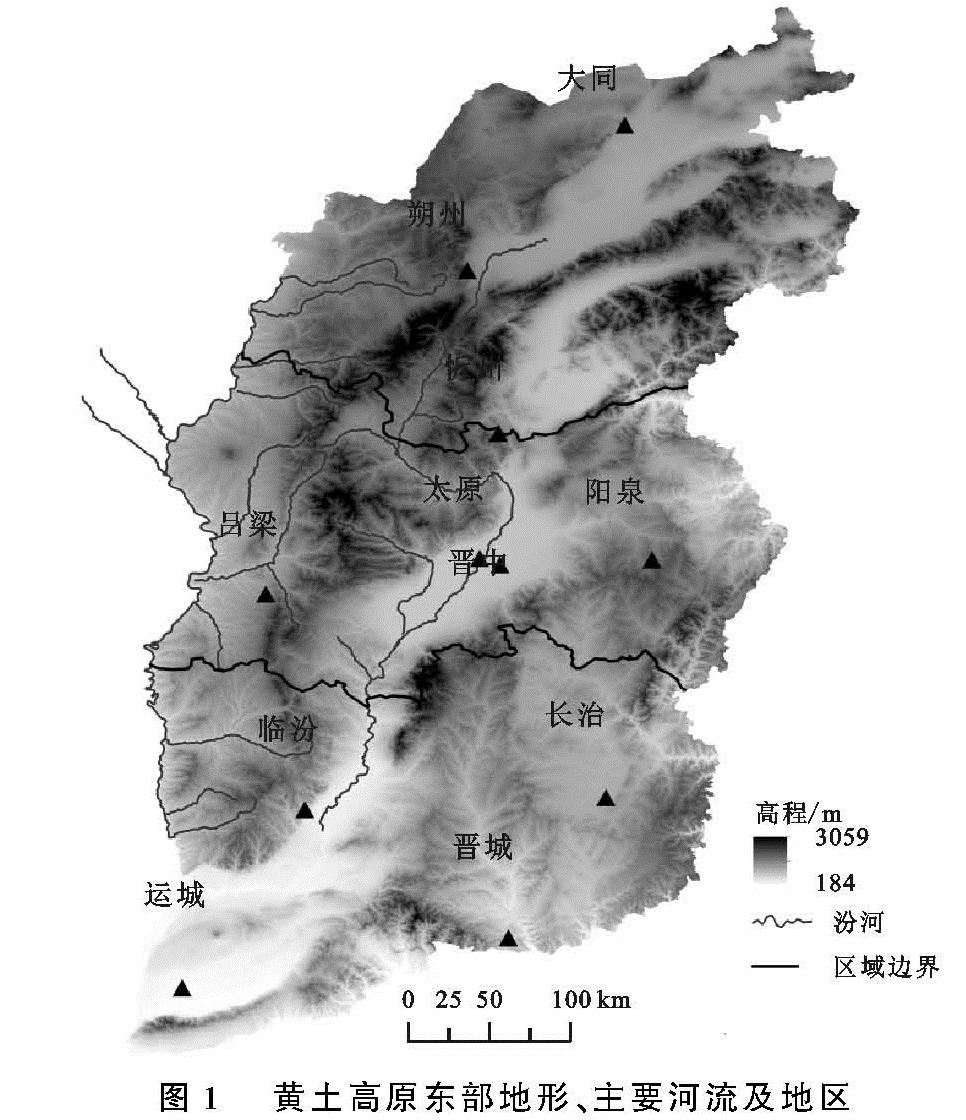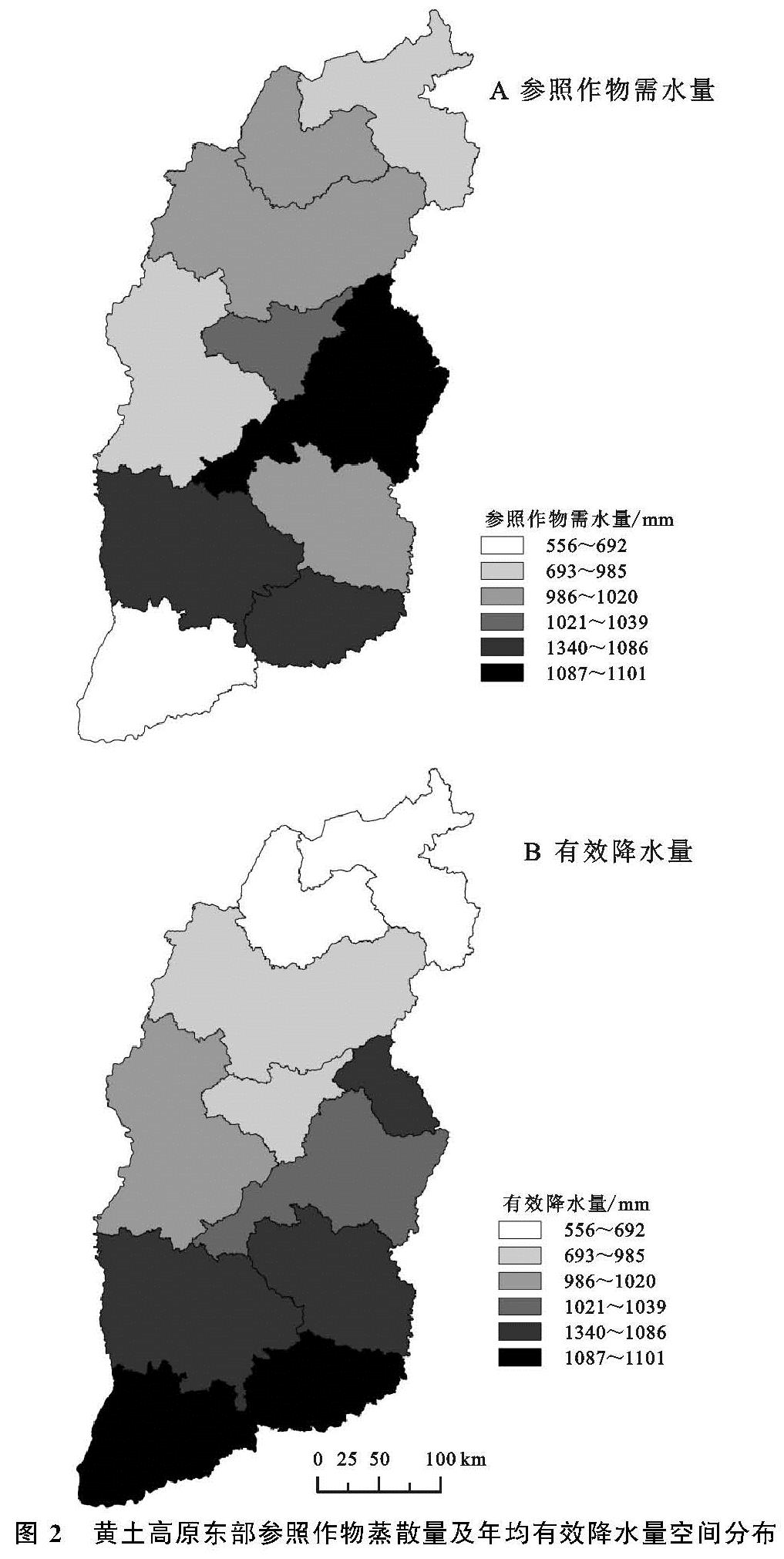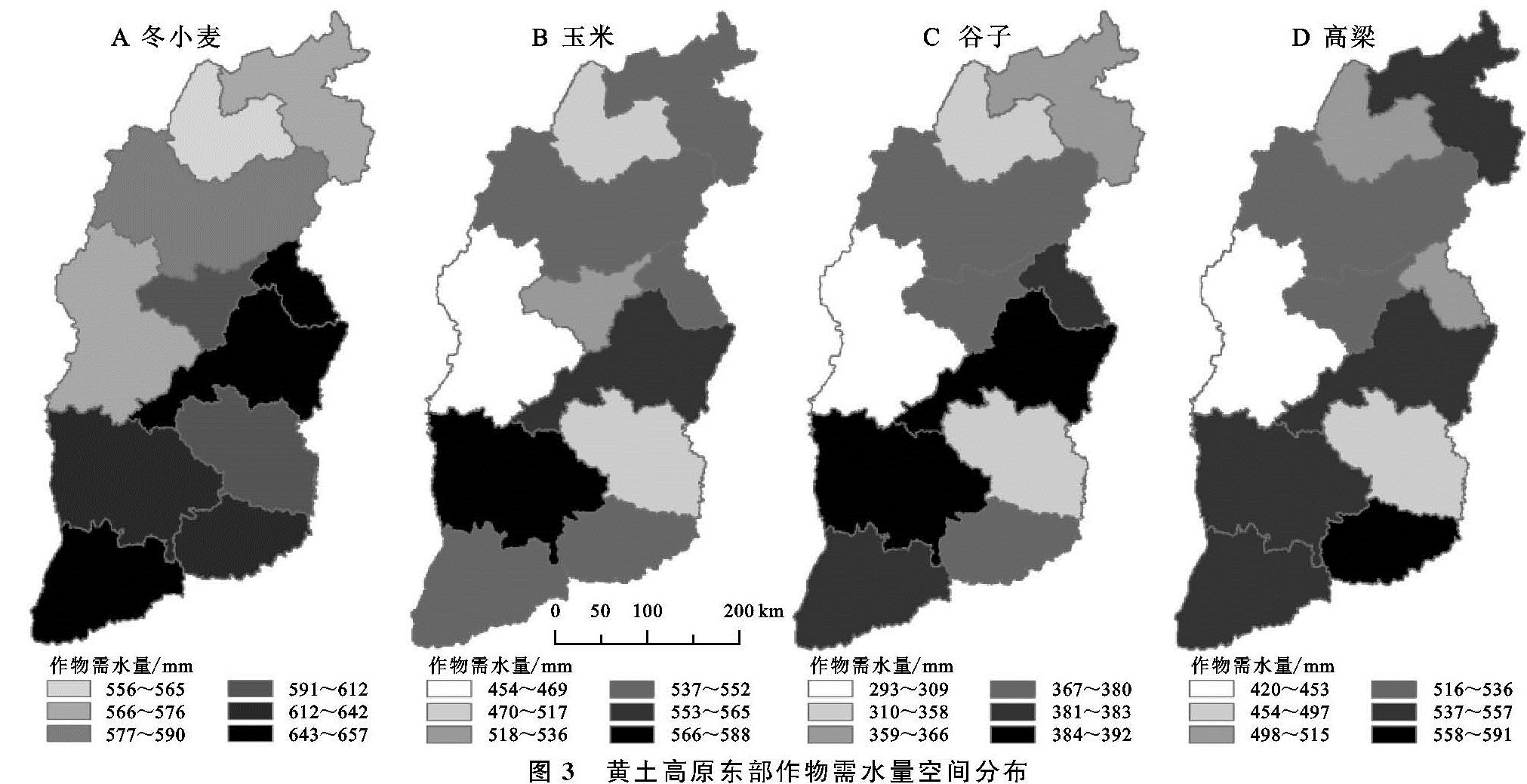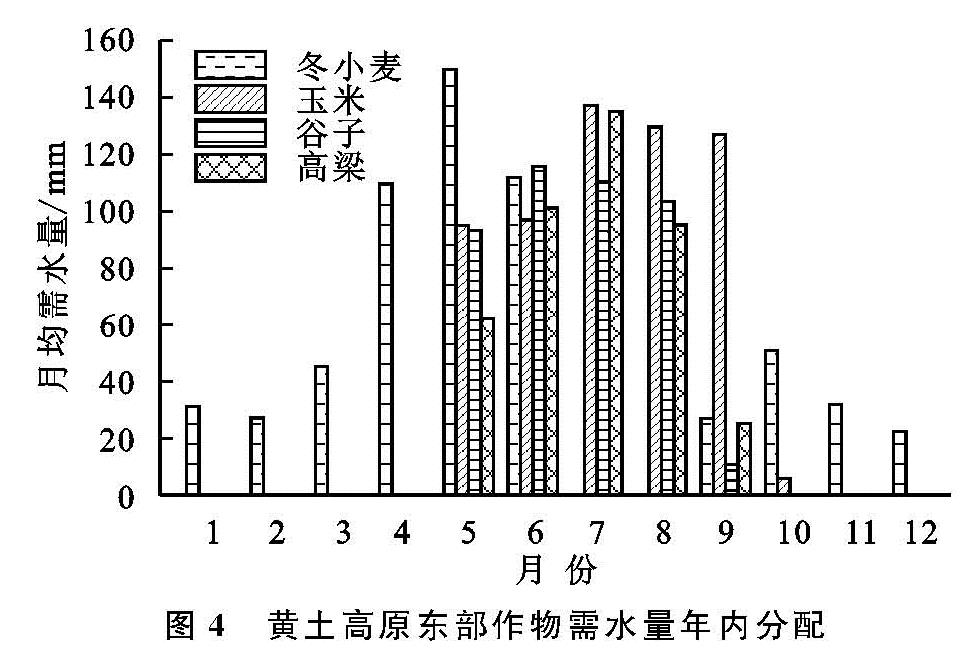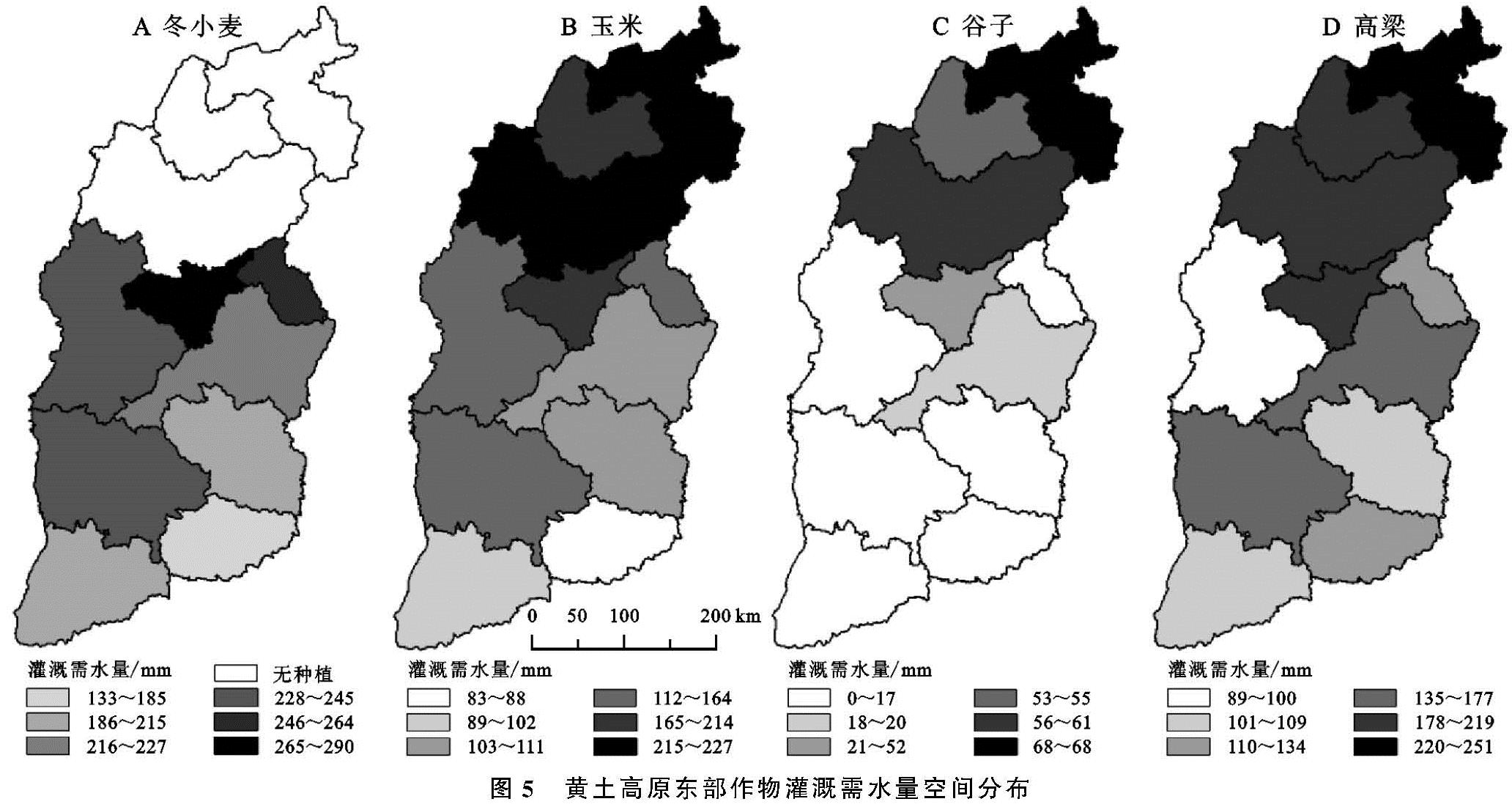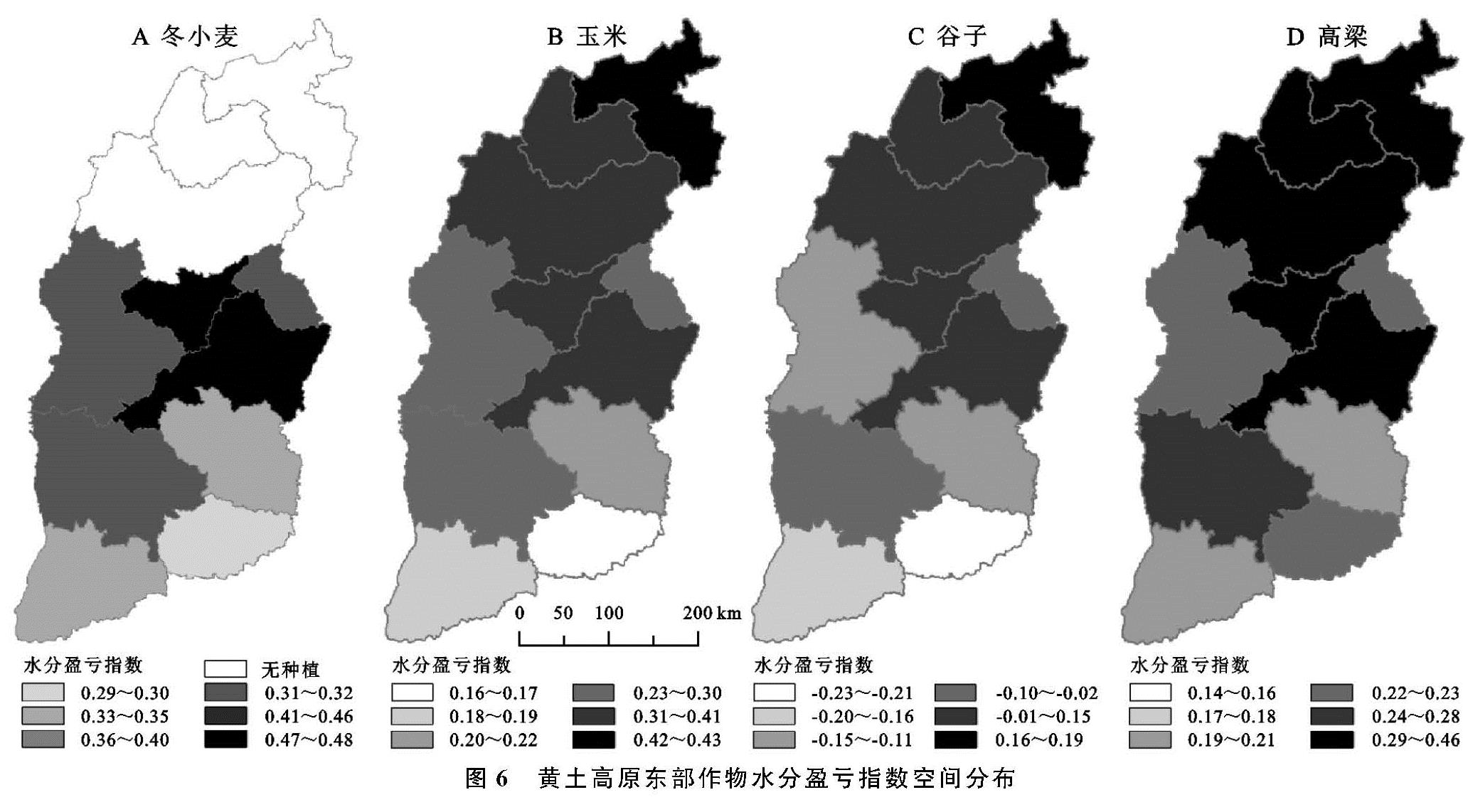3.1 研究区参照作物需水量(ET0)及有效降水(Pe)空间分布特征
本文利用黄土高原东部降水量等数据,计算得出区域参照作物需水量和有效降水量。区域内年均参照作物需水量分布特征如图2A所示,参照作物需水量整体呈南多北少趋势,大同的参照作物需水量最小,为978.76 mm,晋中、阳泉、临汾、晋城的参照作物需水量整体偏大,均大于1 060 mm; 中部吕梁地区是参照作物需水量的相对低值区,为984.1 mm。
图2 黄土高原东部参照作物蒸散量及年均有效降水量空间分布
图2B为黄土高原东部有效降水量空间分布图,由图可知,区域内年均有效降水量区域差异性较大,纬度地带性特征明显,整体呈由南向北呈递减趋势,南部年均有效降水量大于390 mm,北部年均有效降水量小于320 mm,其中南部晋城年均有效降水量最多,为457 mm,北部的大同年均有效降水量最少,为298 mm,年均有效降水量差额在160 mm以上。中部地区有效降水量整体呈周边多、中间少的趋势。
3.2 研究区作物需水量(ETc)时空分布特征
3.2.1 研究区作物需水量空间分布特征
黄土高原东部主要作物需水量空间分布如图3所示。区域冬小麦、玉米、谷子、高粱作物需水量为293.39~656.77 mm,平均作物需水量由多到少依次为冬小麦、玉米、高粱、谷子,分别为613.35 mm,530.24 mm,527.45 mm和368.08 mm。刘涛等研究表明,基于作物需水量,谷子抗旱能力相较冬小麦等具有绝对优势[28]。其中冬小麦、玉米、谷子、高粱等作物需水量最大的地区分别位于阳泉、晋中、晋中、晋城,需水量分别为656.77 mm,564.57 mm,392.39 mm,590.67 mm。冬小麦、玉米、谷子、高粱作物需水量最小的地区为吕梁,分别为575.99 、444.16 mm,293.39 mm和420.12 mm。整体而言,区域北部、中部的吕梁山区及南部长治地区为作物需水量的低值区,主要作物需水量较大地区空间差异明显。
3.2.2 作物需水量季节变化特征
为进一步分析不同作物需水量的年内变化,本研究计算了4类作物需水量的季节变化特征(图4)。研究区主要作物需水量在生长期内呈现先增后减的规律,冬小麦生长期较其他作物长,年内分布较均匀; 玉米、谷子、高粱作物的需水主要集中在夏季和秋季,需水量分别占总需水量的77.55%,97.52%和94.01%。冬小麦作物需水量在9月份到次年3月份较小,需水量为25~60 mm; 而在冬小麦快速生长的4—6月,月需水量均大于110 mm,占全部作物需水量的60%以上; 5月份作物需水量最多,为150 mm。玉米作物需水量5—7月逐月增多,7月份作物需水量为137.36 mm; 8—9月作物需水量缓慢下降,约为127 mm; 10月份迅速减少。谷子、高粱作物需水量较多的月份集中在6月、7月、8月份,9月份作物需水量急剧减少。谷子需水量6月、7月、8月份期较稳定,作物需水量为100~105 mm,后期急剧下降维持在10 mm以上。高粱作物需水量呈单峰形,7月份作物需水量最多,为135 mm,9月份作物需水量最少,为30 mm。比较而言,谷子、高梁较冬小麦和玉米具有生长日期短,需水量较少的特点。
3.3 研究区灌溉需水量(I)空间分布特征
图5为黄土高原东部主要作物灌溉需水量空间分布图,黄土高原东部主要作物灌溉水量整体呈北部大于中南部的趋势。冬小麦灌溉需水量最多的地区为太原,该地区平均灌溉需水量289.69 mm。玉米灌溉需水量表现为北部灌溉需水量多于南部,忻州灌溉需水量最大,该地区平均灌溉需水量为227.05 mm。谷子灌溉需水量由北向南递减,并且在吕梁和南部地区谷子生育期间存在水分盈余,所需灌溉需水量微弱。高粱灌溉需水量整体呈区域中、北部大于南部的空间分布特征,大同地区平均灌溉需水量最多为250.99 mm。曹昌林等对粒用高粱的需水量研究发现从降水量来看,山西省降水基本能够满足高粱的水分所需,但由于降水的不确定性,导致了降雨与需水的不吻合性,需在高粱生长期间进行少量灌溉[29]。区域内4类作物灌溉需水量最多的地区为大同,作物需水量整体由北向南递减,吕梁和区域南部地区为相对作物灌溉需水量低值区。
综上所述,黄土高原东部地区灌溉需水量由北向南呈递减趋势,灌溉需水量最多的地区为北部大同、忻州,南部晋城、运城等地灌溉需水量相对较少。因此,山西北部选取作物种植品种时应优先考虑低耗水作物。
3.4 研究区主要作物水分盈亏(CWDI)特征分析
根据作物水分盈亏指数,本研究计算了黄土高原东部主要作物水分盈亏程度。图6为作物水分盈亏特征分布图,由图可知,研究区冬小麦作物水分盈亏指数相对较大,水分盈亏指数为0.29~0.48,水分盈亏指数最大的地区为太原,最小地区为晋城。玉米水分盈亏指数为0.16~0.43,大同水分盈亏指数最大,晋城水分盈亏指数最小。谷子水分盈亏指数为-0.23~0.19,谷子是唯一水分盈余的作物,大同水分盈亏指数最大,晋城水分盈亏指数最小。高粱水分盈亏指数为0.14~0.46,大同水分盈亏指数最大,运城水分盈亏指数最小。4类作物水分盈亏指数由南向北呈递增趋势。张祖光研究结果显示山西省玉米生育期内总降水与总需水耦合度从北至南依次递增,与本文结论一致[30]。
4类作物的水分盈亏指数东南部相对较低,种植小麦、玉米较为适宜,中部种植小麦、玉米缺水量较大的地区可以通过调整种植结构,适当扩大谷子、高粱种植面积,缓解农业用水压力。北部是水分盈亏指数高值区,不适宜大规模推广作物种植业,应实行退耕还牧。
